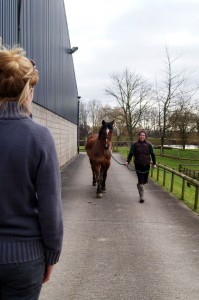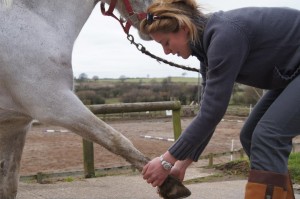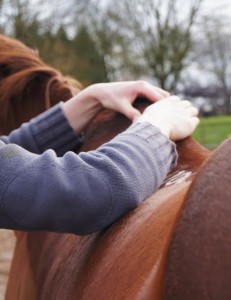What does the treatment involve?
1. History taking
A detailed record of the animal’s past and present problems and symptoms.
2. Static assessment
A full static assessment is undertaken. The animal is felt all over for any areas of tension, heat or swellings indicative of injury, as well as examining for unusual hoof, shoe or claw wear indicative of changes in normal movement.
3. Gait assessment
The animal will be assessed in walk and trot, in-hand. Occasionally in the case of horses, it may be necessary to see the horse on the lunge or under saddle. The gait assessment reveals any lameness, abnormal movement, weaknesses or imbalance.
4. Palpation and adjustment
A series of light, quick adjustments are applied to the required areas which releases the muscle spasm and its associated pain, allowing the joint to return to its normal range of movement and the body to be aligned. The treatment is pain free and most animals readily accept it.

5. Massage
This is carried out on the soft tissues and is an important part of the treatment to improve circulation, improve muscle tone, release toxin build-up and relax muscle spasm. It is also useful to aid with relaxation of stressed, worried horses.
Pre and post competition massage assists with healthy muscles, muscle tone, suppleness and preventing muscle atrophy and tight knotted muscles (fibrositis).
Massage prevents muscle fatigue by increased removal of lactic acid so reduces stiffness after competition and assists with injury and problems during box rest. It also improves blood circulation and lymphatic drainage which helps with blemishes and injuries.
6. Stretching
Stretches are used to allow muscle to relax and mobilise joints. Often, stretching can be the key to increasing range of movement and mobility in a joint. Massage and passive stretching increases synovial joint fluid production and helps to mobilize joints and muscles to maintain optimum range of movement. It improves stride length and muscles will be encouraged to work at maximum efficiency.
7. Aftercare
A full aftercare programme is given at the end of every treatment. This will give tailored advice specific to your animal outlining an exercise/workload programme, any advice on recommended tack/lead/harness changes, any massage/stretches that may be beneficial and any other recommended further treatment.
Can animals be treated if there are no symptoms? Yes, all animals can benefit from McTimoney manipulation as it is also used as a preventative and maintenance measure, as well as recovery.
Few top human athletes would compete without stretching and massage so if your horse is not experiencing any problems or misalignments then this may be of great benefit.








